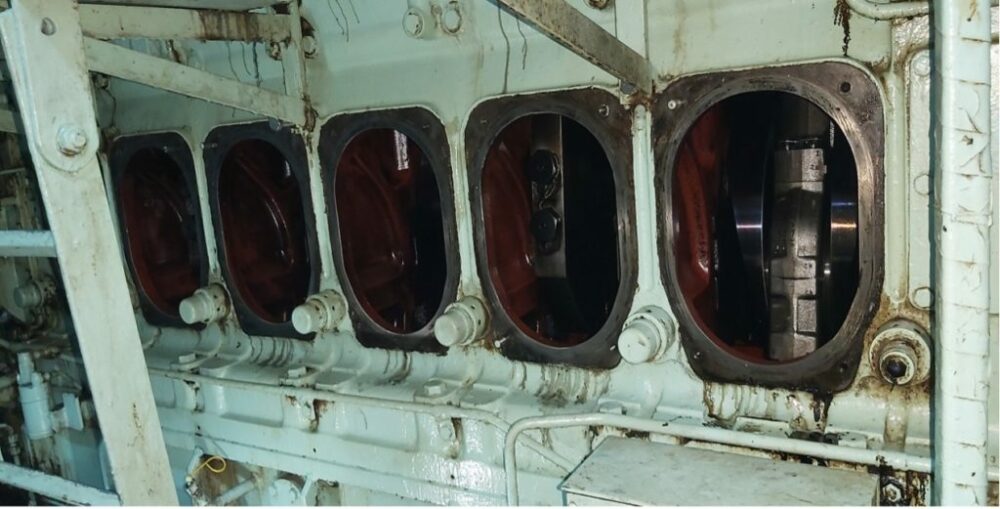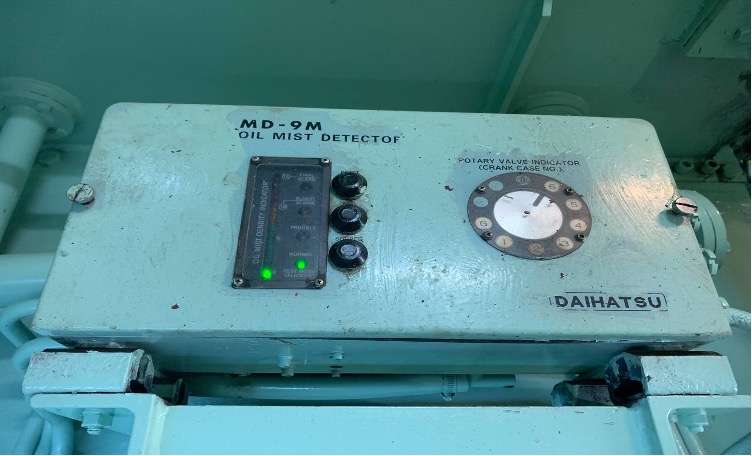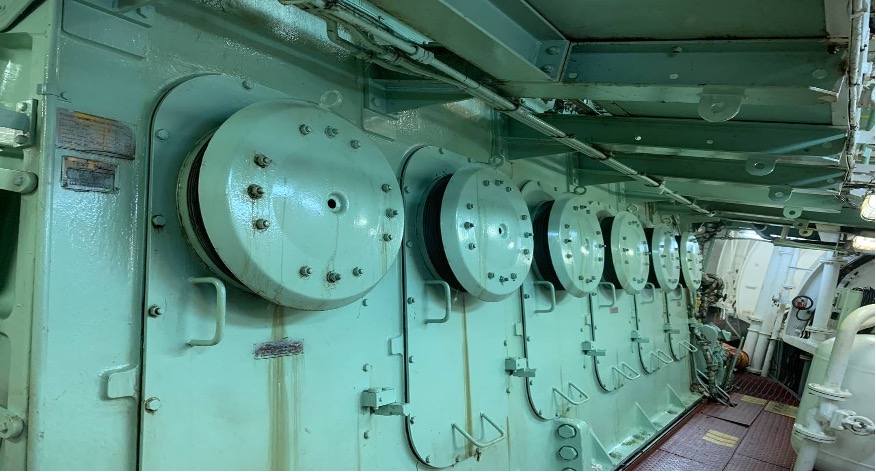Various safety devices are fitted for the safety of the crankcase. They play an active role in the safety and protection of the engine from crankcase explosions.
Crankcase safety devices are:
- Breather pipe with flame trap
- Crankcase exhaust fan
- Oil mist detector
- Crankcase relief doors
- Bearing temperature sensor
- Lubrication oil temperature sensor

What Is The Crankcase Of An Engine?
The crankcase is defined as the area around the crankshaft and crankshaft bearings in the reciprocating internal combustion engine. This area encloses the rotating crankshaft and crankshaft counterweights and directs returning oil into the oil pan.
The crankcase of an engine is formed by the lower part of the block and the engine bedplate. If you what to learn more about a crankcase, then follow the link to the article “Understanding the Crankcase“
For the inspecting and maintenance of the crankshaft and bearings, the block has been provided with doors.
These crankcase doors also have relief valves so that if an explosion occurs in the crankcase, the pressure can be released and damage to the structure can be prevented.
Can A Crankshaft Explode?
The crankshaft is the most important moving part of the engine. It is a part of the mechanism that changes the reciprocating motion of the pistons of all the cylinders to rotational motion to make it ready to be used as engine output.
A crankshaft is made of single cast iron or steel in small engines. More powerful engines it is made of alloy steel. In a four-stroke engine, the crankshaft is drilled with a hole to convey lubricating oil from the main bearing to the bottom end bearings.
During the engine runs a crankshaft could be subjected to fatigue from operating forces. Proper care and maintenance of the crankcase and its internal components including the crankshaft are essential to the smooth running of an engine, the lack of taking proper inspections and maintenance could cause an explosion which will take place in a crankcase and will result in very severe damage and failure of its components.
What Causes A Crankcase Explosion?
As it is known, for a fire or explosion to take place, three basic elements are required to complete the fire triangle. These three components are heat, oxygen, and fuel. In the presence of all these three elements, in proportional ratio and within the flammable limits, the reaction will cause fire or explosion.
In the crankcase of an engine, all three elements required for fire are available. Lube oil as the fuel source is abundantly present, oxygen as one of the three necessary elements is also present and the heat is produced from a hot spot.
Under normal conditions, the hot spot is not enough to generate flammable gas and white mist in the crankcase. But Unable to properly monitor and maintain crankcase equipment will develop a mechanical fault and possibly could create a hot spot in the crankcase due to continuous rubbing of moving parts. These mechanical faults could take place due to the following reasons:
- Lubrication failure
- Piston misalignment causing friction at the stuffing box
- Incorrect spring mounted in piston rod stuffing box
- Main and camshaft bearing wear and tear
- Piston crown failure
- Crankshaft failure
- Weight on-chain tightener falling off
- Incorrect shaft in camshaft drive, etc…
And this adds up the heat and creates a favorable condition for the three elements to come together which could cause crankcase explosions. This explosion can be a product of primary and secondary explosions. For the primary explosion, if the hot spot comes in contact with the lubricating oil, vaporization takes place.
The vapor then circulates to a cooler part in the crankcase and condenses into a white oil mist. The white oil mist would reach a certain concentration, and upon the explosive limit, the crankcase explosion occurs.
For the secondary explosion, the primary explosion produces a shock wave that propagates inside the crankcase and it has a breaking effect to reduce the size of the oil droplet, producing more fuel for ignition.
The pressure which was created due to the primary explosion would leave the crankcase through crankcase doors and would generate a low-pressure area that tries to suck more air from outside. If there is a leak from the relief valve, the stuffing box, and the crankcase vent, a good environment with more fuel and air would be present.
Usually, the crankcase door may get ruptured. The hot spot then ignites the flame and cause a secondary explosion which is a more violent and catastrophic explosion that can damage the main engine, injure crew member, or even can cause death.
What Is A Hot Spot In An Engine?
A hot spot is a very high-temperature surface (between 200 to 400 degrees Celsius) produced as a result of abnormal friction between two metal parts such as crosshead and guides, piston rod and gland, chain and gear drive, etc. In most cases, the hot spot is caused by poor maintenance and insufficient clearance.
There is a possibility that the hot spot could occur in an engine due to a combination of the following:
- Stuffing box leakage erasure-by through a cracked piston crown or piston rod with connection to the crankcase via the cooling oil outlet pipe.
- A hot spot in an engine could also develop from a scavenge fire being transmitted down by the piston rod or via the stuffing box into the crankcase.
We can detect the presence of a hot spot in a crankcase by simply touching the surface of the crankcase door. Other techniques for detecting hot spots in an engine include:
- Oil mist detector alarms indicate the presence of oil mist.
- Heavy noise with the abnormal operation of the engine.
- The appearance of dense mist from the breather pipe.
- Irregular operation of engine sudden surge in exhaust temperature.
- High lubrication oil temperature alarms.
What Is The Prevention Of Crankcase Explosion?
Crankcase explosion can be avoided by not allowing a hot spot to form in the first place. If a hot area like this exists and oil mist forms, immediate action is required to prevent an explosion. The formation of a hot spot can be avoided by adequate cooling of an engine. Also, the followings are very crucial;
- A regular check of bearing clearances and in case of out of normal range, It has to be changed as soon as possible
- Check the lubrication passages are clear and there is an adequate flow of oil from the passages.
- Check the quality of lubrication oil is good quality and purification is efficiently maintained.
- The accumulation on the filters to be checked for metals and other deposits if found must be cleared.
- Rubbing surfaces like crosshead guide, stuffing box, and piston rod are to be checked for lubrication, wear and tear.
- Check to work of the oil mist detector and other setups like crankcase doors for proper working.
- Check any abnormality in terms of noise or operation must be looked after. And In addition, we also need to ensure there is proper cylinder lubrication in the engine; no oil leaks, all alarms, and safety trips working.
Crankcase Safety Devices
Big engines are fitted with warning devices to warn the engineers if the crankcase conditions are abnormal. These early safety devices can be:
- An oil mist detector is a safety device, fitted in marine diesel engines to check and monitor crankcase environments for the presence of oil mist. Within its flammable range, it can detect the presence of oil mist. As a result, it aids in early detection and prevents primary crankcase explosion. It consists of six parts; a reference tube, light source, sampling point, extraction fan, measuring tube, and rotary vane.

- Temperature sensors indicate the formation of a hot spot.
Both these devices give an alarm, and in some ships cause an automatic slowdown of the main engine. On receiving the alarm, the engineers can take the necessary steps to prevent an explosion.
In case a crankcase explosion does take place, engines are so made and fitted with devices that minimize damage to the engine, ship, and personnel.
- The crankcase is made strong enough to withstand the pressure of the explosion so that the casing of the engine is not damaged.
- Explosion relief doors are fitted to relieve the pressure on the engine room.
The crankcase relief valve is fitted on the crankcase door. It consists of a non-return disc valve, a valve cover, a deflector, a dome-shaped flame trap, and the valve spring. Any increase in pressure, such as in the case of a primary crankcase explosion, is released.

To protect any crew around during a release, the deflector is designed to redirect them downwards away from the operators. Any abrupt increase in pressure, such as in the case of a primary crankcase explosion, is released. Being a non-return valve it only allows the air to go from inside to out and not vice versa. Except for engines that are too small, all engines must be equipped with a similar safety device.
To achieve instantaneous action and positive shutting, the valve must be spring-loaded. In the event of a primary explosion that dissipates energy. Then it closes instantly as the pressure drop. The classification society specifies the recommended number, size, and operating pressure of these valves.
What Should I Check During The Crankcase Inspection?
Carrying out the crankcase inspection is one of the most important things for the efficient running of the main engine on the ship. The purpose of the inspection is to ensure that no abnormal things happened on the main components, fixing bolts or piping during the last voyage.
Whenever there is enough time to perform, a crankcase inspection should be carried out every month. The checks during the inspection are
- Check for the appearance of all parts inside the crankcase
- Check for any distinguished smell
- Check for hot spot
- Check for Corrosion
- Wear and tear
- Bolts tightness
- Look for Chain condition
- Metal residues in the crankcase
- Bearing clearances
- Crankcase door joints statuses
- Crankcase relief valve, inspect the condition of the flame arrester
- Crankshaft deflection
- Check to see if anything is left inside before exiting the crankcase.
- Types of Gas Carriers as per IGC Code – April 22, 2025
- Wind-Assisted Propulsion Systems (WAPS): A Game Changer for Maritime Decarbonization – February 6, 2025
- 10 Boat Salvage Yards in California – January 25, 2025




